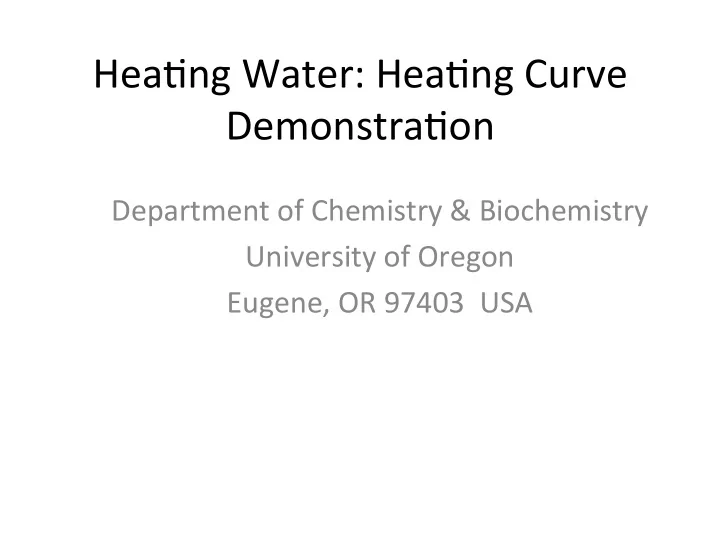

Hea$ng Water: Hea$ng Curve Demonstra$on Department of Chemistry & Biochemistry University of Oregon Eugene, OR 97403 USA
Make a list: differences & similarities Boiling vs. Evaporation Write a definition for boiling and for evaporation.
2 pts Boiling – what is going on when we boil water? Which equa$on best represents the process? A. H 2 O (l) à H 2 O (g) B. 2 H 2 O (l) à 2 H 2 (g) + O 2 (g) C. H 2 O (g) à H 2 O (l) D. 2 H 2 (g) + O 2 (g) à H 2 O (l) E. H 2 O (l) à 2 H (g) + O (g)
Boiling represents the transition from liquid to gas . • boiling water: H 2 O (l) à H 2 O (g) • boiling ethanol: CH 3 CH 2 OH (l) à CH 3 CH 2 OH (g) If VP < external pressure, bubble collapses. If VP > external pressure, boiling can occur The boiling point of a liquid is the temperature at which the vapor pressure equals the external pressure.
All substances at the same temperature have the same average kinetic energy. However, there is always a distribution of velocities, leading to a distribution of kinetic energies. A certain fraction has enough energy to escape into the gas phase. Average kinetic energy Minimum escape kinetic energy
Evaporation Big Concept: molecules in a liquid state must have sufficient kinetic energy to overcome the intermolecular forces of attraction operating among the liquid molecules. Strong IMFs between molecules => Force of attraction is Strong Gas H 2 O phase Liquid phase
List the distinct steps involved in taking ice at -25°C to steam at 125°C .
Energy Changes Associated with Changes of State 0°C 100°C heating heating heating melting boiling H 2 O (s) H 2 O (l) H 2 O (g) (ice) (water) (steam) There is energy associated with each of these 5 processes.
Temperature (°C) Time (minutes)
For example, how much energy is associated with heating one mole of H 2 O from -25°C to 125°C? There are 5 steps involved in this process: 1) hea$ng of the ice to its mel$ng point 2) the phase change from solid to liquid 3) hea$ng of the liquid to its boiling point 4) the phase change from liquid to gas 5) hea$ng the gas to the final temperature energy associated with heating: q = m × c × Δ T energy associated with phase changes q = ( Δ H phase change )(number of moles) q = (kJ/mol)(mol)
Total Energy Required The total energy is the sum of the energies for each step: q1 + q2 + q3 + q4 + q5 = q total Be careful with signs and units!
How much energy is associated with heating one mole of H 2 O from -25°C to 125°C? Water molar mass 18 g/mol boiling point 100°C Freezing point 0°C Heat of vaporiza$on 40.7 kJ/mol Heat of fusion 6.02 kJ/mol specific heat capacity (liquid) 4.18 J/g°C specific heat capacity (gas) 2.01 J/g°C specific heat capacity (solid) 2.09 J/g°C
2 pts Region 1 solid ice at -25°C to solid ice at 0.0°C • Heating 1.00 mole of ice at − 25.0 °C up to the melting point, ice at 0.0 °C • q = mass × c ice × Δ T – Mass of 1.00 mole of H 2 O = 18.0 g – c ice = 2.09 J/g ·°C 5 4 3 2 1 q = (18.0 g)(2.09 J/g°C)[0.0°C-(-25.0°C)] q = 941 J q = 0.941 kJ
Region 2 solid ice at 0*C to liquid water at 0°C • Melting 1.00 mole of ice at the melting point, 0.0 °C a phase change solid -> liquid • q = n · Δ H fus 5 4 n = 1.00 mole of ice 3 Δ H fus = 6.02 kJ/mol 2 1 q = (1.00 mol) (6.02 kJ/mol) = 6.02 kJ
Region 3 water at 0°C to water at 100°C • Heating 1.00 mole of water at 0.0 °C up to the boiling point, 100.0 °C 5 4 • q = mass × c water × Δ T 3 mass of 1.00 mole of water = 18.0 g 2 c water = 4.18 J/g · °C 1 q = (18.0 g)(4.18 J/g°C)(100.0°C-0.0°C) q = 7.52 x 10 3 J q = 7.52 kJ
Region 4 water at 100°C to steam at 100°C • Boiling 1.00 mole of water at the boiling point, 100.0 °C (phase change) • q = n · Δ H vap 5 4 n = 1.00 mole of ice 3 Δ H vap = 40.7 kJ/mol 2 1 q = (1.00 mol) (40.7 kJ/mol) = 40.7 kJ
Region 5 steam at 100°C to steam at 125°C • Heating 1.00 mole of steam at 100.0 °C up to 125.0 °C • q = mass × c steam × Δ T mass of 1.00 mole of water = 18.0 g c steam = 2.01 J/g·°C q = (18.0 g)(2.01 J/g°C)(125.0°C-100.0°C) q = 904 J = 0.904 kJ 5 4 3 2 1
Total Energy Required The total energy is the sum of the energies for each step: q1 + q2 + q3 + q4 + q5 = q total 0.941 kJ + 6.02 kJ + 7.52 kJ + 40.7 kJ + 0.904 kJ = 56.08 kJ Be careful with signs and units!
Energy Changes Associated with Changes of State • The heat added to the system at the melting and boiling points goes into pulling the molecules farther apart from each other. • The temperature of the substance does not rise during a phase change.
Energy Changes Associated with Changes of State 5 4 3 2 1
Recommend
More recommend